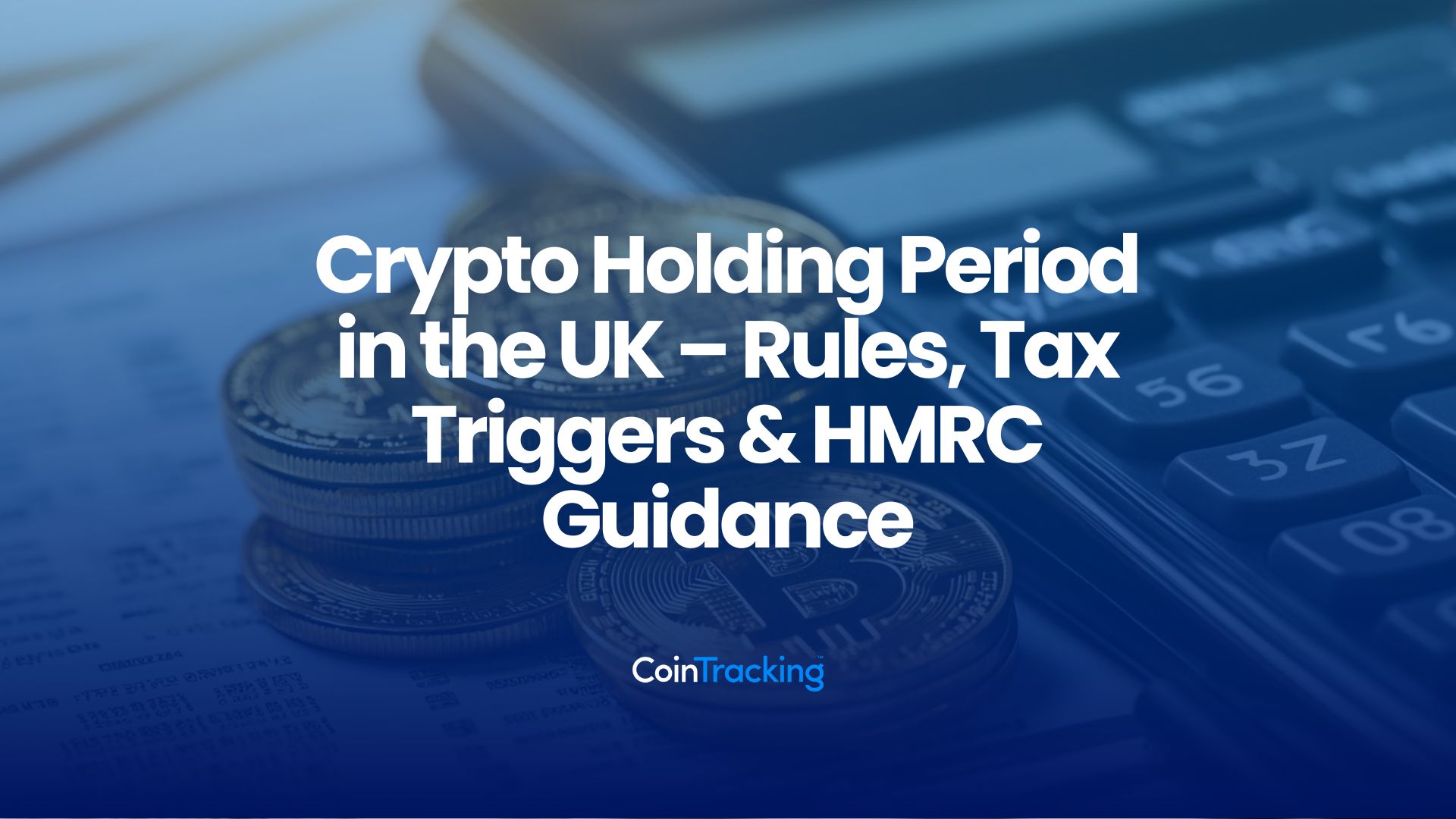Understanding how the crypto holding period works in the UK can help you plan trades and reduce your tax bill. HMRC doesn’t follow a simple “hold for 12 months and it’s tax-free” approach. Instead, it uses matching and pooling rules to determine which assets you’ve sold and when you bought them.
In this guide, we’ll break down the rules, show how your holding period is calculated, and explain how different activities like staking or airdrops can affect it. For a full overview of how crypto is taxed in the UK, check out our detailed guide on Crypto Taxes in the UK.
Key Takeaways about the Crypto Holding Period in the UK
- There is no automatic tax-free status after holding crypto for 12 months
- HMRC uses specific matching and pooling rules to calculate gains
- The holding period starts from the date you acquire the asset
- Activities like staking, airdrops, and forks can affect your acquisition date
- CoinTracking helps you track your crypto transactions and apply the correct HMRC rules automatically.
Does the UK Have a 12-Month Holding Rule?
The UK does not have a simple 12-month rule that makes crypto tax-free after a year. Instead, all disposals of crypto are subject to Capital Gains Tax (CGT) unless they fall within your annual CGT allowance. Disposals include:
- Selling crypto for GBP or another fiat currency
- Swapping one cryptocurrency for another
- Using crypto to pay for goods or services
- Gifting crypto (except to your spouse or civil partner)
This means that even if you have held a coin for several years, you could still owe tax when you dispose of it. HMRC’s rules focus on how gains are calculated, not on a fixed holding period that removes tax liability. For more details on taxable events, see our Crypto Taxes in the UK guide.
HMRC Holding Period Rules: Matching & Pooling Explained
HMRC does not track each crypto asset individually. Instead, it uses matching and pooling rules to decide which acquisition date and cost basis apply when you dispose of crypto. These rules are important because they directly affect your holding period and the size of your taxable gain.
1. Same-Day Rule
If you sell crypto and you also bought the same type of crypto on the same day, HMRC will match those purchases to your sale first.
Explanation: Because the purchase and sale happened on the same day, HMRC ignores your older holdings. The gain is simply the difference between the buy and sell prices from that day, resulting in a gain of £1,000 in this example.
2. 30-Day Rule (Bed and Breakfast Rule)
If you sell crypto and then buy the same type within the next 30 days, HMRC matches that future purchase to your sale before looking at your older holdings.
Explanation: Even though the new purchase happened after the sale, HMRC still pairs it with the sale because it was within 30 days, resulting in a gain of £400 in this example. This rule stops people from selling and quickly buying back to create a tax loss.
All Crypto Investments at a Glance
3. Section 104 Pool (Everything Else)
After the same-day and 30-day rules, any remaining crypto you sell is matched to your Section 104 pool. This pool groups all the coins of the same type you own, and averages their cost.
Explanation: The pool takes the average cost of all your BTC in the same group:
(£15,000 + £18,000 + £21,000) ÷ 3 = £18,000
When you sell from the pool, the gain or loss is based on the sale price minus the average cost, resulting in a gain of £2,000 in this example.
Why it matters: These rules mean the “holding period” for UK tax purposes can be very different from how long you’ve personally held the asset. Selling can match to coins you bought later or earlier than you expect.
How Staking, Airdrops & Forks Affect Holding Periods
Some crypto events provide you with new coins without you buying them. HMRC still needs a “starting point” for these coins so they can be included in your tax calculations. These events can start a new holding period for the tokens you receive.
1. Staking Rewards
When you receive staking rewards, HMRC treats them as taxable income on the date you get them. The value on that day becomes your cost basis, and the holding period starts from that date.
Explanation: £20 is added to your income for the tax year. If you later sell these ADA, your gain or loss is based on the sale price compared to £0.40 per token, and your holding period starts from 1 June. Read more in our Guide about Crypto Staking Taxes in the UK.
2. Lending
If you lend your crypto and earn interest (in crypto), HMRC treats the interest payments as taxable income when you receive them. The value on that date becomes your cost basis, and the holding period for the received coins starts from that date.
Explanation: £80 is added to your income for the tax year. If you later sell these USDT, the gain or loss is based on the sale price compared to £0.80 each, and your holding period starts on 5 September. Read more in our Guide about Crypto Lending Taxes in the UK.
3. Airdrops
When you get coins from an airdrop, HMRC normally treats them as income (if you did something to earn them) or with a zero cost basis (if you didn’t do anything in return to get them). In both cases, the holding period starts the day you receive them.
Explanation: £800 is added to your income for the tax year if considered taxable income. If you later sell these UNI, the gain or loss is based on the sale price compared to £2.00 each, and your holding period starts on 10 July. Read more in our Guide about Crypto Airdrop Taxes in the UK.
4. Chain Forks
If a blockchain forks and you get coins from the new chain, HMRC says the cost of your original coins is split between the old and new coins based on their market values right after the fork. Forked coins are not treated as income, but their holding period starts on the fork date.
Explanation: You now hold both BTC and BCH. The original BTC’s cost is reduced, and BCH gets a new starting value and holding period from 1 August. If BTC is worth £3,600 and BCH £400 right after the fork (total £4,000), 90% of your original cost stays with BTC and 10% is given to BCH. This split ensures both assets have a starting value for capital gains calculations.
Events like staking, lending, and airdrops can create twotax points: one for the income you receive and another when you later sell the coins. Tracking these manually is time-consuming, but CoinTracking can record the correct cost basis and holding period for each event automatically.
The Best Crypto Tax Calculator!
Holding Period Rules for Crypto Trading in the UK
If you trade crypto frequently, HMRC’s same-day rule, 30-day rule, and Section 104 pool still apply. This means your profits and losses will often be based on very recent trades, even if you also hold some crypto long term.
For most UK investors, frequent trading is still taxed under Capital Gains Tax (CGT) rules, unless HMRC decides your trading looks like a business.
1. Frequent Trading Example (Day Trader)
Explanation: Because the purchase and sale happen on the same day, the same-day rule applies. HMRC ignores any older ETH you might own. The total gain of £250 (£50 each) is subject to CGT.
2. Short-Term Rebuy Example (30-Day Rule)
Explanation: Here the 30-day rule applies because the repurchase happens within 30 days of the sale. HMRC matches the sale to the new purchase at £14,500, not to any older BTC you might have. The gain of £500 is subject to CGT. This rule exists to stop “bed and breakfasting” (selling and quickly rebuying to create an artificial loss).
3. Long-Term Holding Example (Section 104 Pool)
Average cost per ADA: (£400 + £300) ÷ 1,500 = £0.4666
Explanation: Neither the same-day nor the 30-day rules apply here, so the sale is matched to the Section 104 pool. The pooled average cost is £0.4666 per ADA. Selling 500 ADA for £0.70 each gives a gain of about £116.70 in total. Even if you’ve held some of these coins for years, the calculation is based on the average cost of all ADA in the pool.
How Gifting, Donations & Inheritance Affect Holding Periods
Some transfers of crypto are treated as sales for tax purposes, while others are not. HMRC has different rules depending on who you give the crypto to and why.
Gifting to a Spouse or Civil Partner
If you gift crypto to your spouse or civil partner, HMRC applies a no gain/no loss rule. This means there is no immediate Capital Gains Tax to pay. Your spouse takes over your original cost basis and your original holding period. Essentially, they step into your shoes for tax purposes.
Gifting to Others
If you gift crypto to anyone else, such as friends, family members (not spouses), or anyone outside your household, HMRC treats it as if you sold it at market value on the date of the gift. This triggers Capital Gains Tax if your gains exceed your annual allowance. For the recipient, the cost basis is the market value on the date they receive it, and their holding period starts from that day.
Donations to Charity
Donations of crypto to a registered UK charity are generally exempt from Capital Gains Tax, provided the donation is made outright and without conditions.
Inheritance
When crypto is passed on after death, there is no Capital Gains Tax at that point. Instead, the crypto is valued at probate value on the date of death. This value becomes the cost basis for the person inheriting the asset, and their holding period starts from that date. Inheritance Tax may apply depending on the size of the estate.
Crypto Holding Period Rules in Other Countries
Germany
Germany offers one of the most generous rules for long-term holders. If you hold crypto for more than 1 year before selling, your gains are completely tax-free. Learn more in our guide on crypto taxes in Germany.
Austria
Austria used to have a 1-year tax-free rule, but from 1 March 2022, crypto gains are taxed at a flat rate of 27.5%. There’s no longer a benefit for holding long term, unless the asset was acquired before that date, in which case the old 1-year exemption still applies. Learn more in our guide on crypto taxes in Austria.
USA
The US splits crypto gains into short-term (held for 1 year or less) and long-term (held for more than 1 year). The 1-year holding period is counted from the day after you acquire the asset to the day you sell it. Learn more in our guide on crypto taxes in the US.
FAQ about the Crypto Holding Period in the UK
Does the UK Have a 12-Month Holding Rule?
No. The UK does not make crypto gains tax-free after 12 months. HMRC uses same-day, 30-day, and Section 104 pooling rules to work out your cost basis. See our explanation of HMRC matching rules.
When are cryptos tax-free?
Crypto disposals are only tax-free if your total gains for the year are below the annual Capital Gains Tax allowance (£3,000 in 2024-25) or if they are exempt transactions, such as outright donations to a registered UK charity.
How long do I need to hold cryptos?
There’s no minimum holding period to avoid tax in the UK. Your gains are taxed whenever you dispose of crypto, no matter how long you’ve held it, unless they fall within your annual allowance or are exempt.
How does staking affect the holding period for my crypto assets?
Staking rewards are treated as income on the date you receive them. That date becomes your cost basis and the start of the holding period for those specific tokens. Read our staking tax guide.
Does gifting cryptocurrencies affect the holding period?
Yes. Gifting to your spouse or civil partner transfers your original cost basis and holding period to them. Gifting to anyone else is treated as a sale at market value, triggering CGT and starting a new holding period for the recipient.
Conclusion - Plan Your Holding Period to Reduce UK Crypto Taxes
There’s no simple one-year tax break in the UK. HMRC’s same-day, 30-day, and Section 104 pooling rules decide which coins you’ve “sold” for tax purposes, so timing matters. Events like staking, lending, airdrops, and gifts start new holding periods for the assets you receive. CoinTracking can apply HMRC’s rules automatically, keep your cost basis correct, and make tax reporting much easier.
Disclaimer
The information provided in this article is for educational and informational purposes only. It is not intended as financial, investment, tax, or legal advice. Cryptocurrency investments are highly volatile and carry significant risks. Before investing in cryptocurrencies, conduct thorough research, consult with a financial advisor, and ensure you understand the risks involved. The author and publisher are not responsible for any financial losses or damages that may occur from following the information presented in this article. Always use caution and make informed decisions when dealing with cryptocurrencies.






